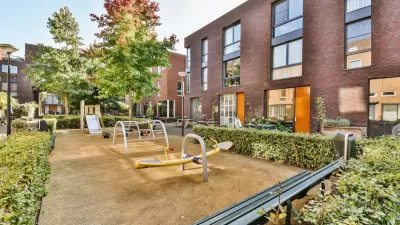It is conventional wisdom that suburbs are more attractive to families with children than cities. But in fact, the most dense urban cores are gaining children to a greater extent than their suburbs.

Last week, an article in The Atlantic got a great deal of online publicity by claiming that although American cities are successful in attracting young college graduates, they cannot compete with suburbs in attracting families. The author correctly notes that "In 2018, the U.S. fertility rate fell to its all-time low" and then goes on to suggest that, for families, suburbs are somehow "more efficient" than cities.
But this argument is based on the assumption that the United States "Birth Dearth" is limited to cities. Census data from the American Community Survey (ACS) shows that the American fertility problem is in large part a suburban problem. For example, Census Bureau data shows that in 2010, Long Island's exurban Suffolk County had just over 85,000 people under the age of 5. In 2018, it had only 79,299. Similarly, in Westchester County just north of New York City the number of under-5 children nosedived from just over 57,000 to 53,786 during this period. By contrast, the number of children under 5 in Manhattan has held roughly steady over the course of the decade, increasing slightly from 76,579 in 2010 to 76,939 in 2018.* And in Brooklyn, the number of small children increased more significantly, from 177,198 in 2010 to 187,240 in 2018.
New York's suburbs are not alone. In suburban Philadelphia's Montgomery County, the number of under-5 children declined from 47,305 to 45,445. In nearby Bucks County that number plunged from over 34,000 in 2010 to 30,904 in 2018. In suburban Chicago’s Lake County that number plunged from over 47,000 in 2010 to 40,191 in 2018. In suburban San Francisco's San Mateo County, the number decreased from 46,360 in 2010 to 45,345 in 2018. And in the United States as a whole, the number of children under 5 declined by a smaller margin, from 20.2 million to 19.8 million. These estimates, if true, mean that Manhattan is actually doing a better job of retaining small children than the United States as a whole.
Furthermore, not all urban cores are doing poorly in retaining children. Washington, D.C. had just under 32,000 children under 5 in 2010, and has over 45,000 today.** In Philadelphia, the number of children under 5 increased from just over 101,000 in 2010 to 104,152 in 2018. Even in San Francisco (which, according to The Atlantic article, “has the lowest share of children of any of the largest 100 cities in the U.S.”), the number of under-5 children increased from 35,203 in 2010 to 39,722 in 2018.
Of course, the ACS date are just estimates, rather than data derived from an actual count of individuals. But to the extent they are correct, they suggest that at least some dense urban cores might actually be gaining children, and that many suburbs are losing children.
*The article claims that "the number of babies born in New York has declined 9 percent in the five boroughs and 15 percent in Manhattan." No link was supplied to support this claim. However, I was able to find live birth data from New York State statistics, and this is what I found: New York City had 118,902 births in 1997 and 114,400 in 2016—a 3 percent decrease. But births in New York's largest suburban counties plunged by 15-25 percent during this period—from 17,100 to 14,277 in Nassau, 19,862 to 15,539 in Suffolk, and 12,655 to 10,273 in Westchester. Birth data are also available online.
**The article claims that in Washington, "the number of children under the age of 18 has declined." But the link supplied to justify this claim refers "to the first decade of this century" and is thus outdated.

Planetizen Federal Action Tracker
A weekly monitor of how Trump’s orders and actions are impacting planners and planning in America.

Restaurant Patios Were a Pandemic Win — Why Were They so Hard to Keep?
Social distancing requirements and changes in travel patterns prompted cities to pilot new uses for street and sidewalk space. Then it got complicated.

Map: Where Senate Republicans Want to Sell Your Public Lands
For public land advocates, the Senate Republicans’ proposal to sell millions of acres of public land in the West is “the biggest fight of their careers.”

Maui's Vacation Rental Debate Turns Ugly
Verbal attacks, misinformation campaigns and fistfights plague a high-stakes debate to convert thousands of vacation rentals into long-term housing.

San Francisco Suspends Traffic Calming Amidst Record Deaths
Citing “a challenging fiscal landscape,” the city will cease the program on the heels of 42 traffic deaths, including 24 pedestrians.

California Homeless Arrests, Citations Spike After Ruling
An investigation reveals that anti-homeless actions increased up to 500% after Grants Pass v. Johnson — even in cities claiming no policy change.
Urban Design for Planners 1: Software Tools
This six-course series explores essential urban design concepts using open source software and equips planners with the tools they need to participate fully in the urban design process.
Planning for Universal Design
Learn the tools for implementing Universal Design in planning regulations.
Heyer Gruel & Associates PA
JM Goldson LLC
Custer County Colorado
City of Camden Redevelopment Agency
City of Astoria
Transportation Research & Education Center (TREC) at Portland State University
Camden Redevelopment Agency
City of Claremont
Municipality of Princeton (NJ)






























